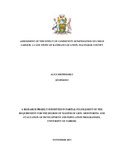| dc.description.abstract | This study is an assessment of the effect of community sensitization on child labour: a case
study of Kathiani location, Machakos County. International Labour Organisation (2013)
refers to child labour as work which is done by children although they should not be doing
because they are either too young to work or because such work exposes the children to
dangerous and unsuitable circumstances. ILO’s statistics indicate that 168 million children
globally and 58 million children in Africa engage in child labour, and 4.55 million of these
are from Kenya. While studies related to child labour have been done both at a global level
and at a regional level, most researchers have focused mostly on the causal factors of child
labour and their impact to the economy. Little has been done regarding the mitigating factors
of child labour, and less so, the use of community sensitization as a mitigation tool on child
labour. In 2012, Kenya Alliance for Advancement of Children implemented a project on
elimination of child labour in four counties to determine the situation of child labour, and
concluded that there was high prevalence of child labour in the four counties. The
organisation further implemented community sensitization strategies to help curb child
labour, but with no follow-up study assess the effect of community sensitization on child
labour.
This study is the first follow-up study with the aim of assessing the effect of community
sensitization on child labour, taking Kathiani location as a case study. The objectives of this
study were to determine the change in the level of child labour between the baseline and
endline surveys, and to establish the effect of community sensitization on child labour in
Kathiani. This study used a pre-post research approach. The study engaged 235 respondents
in total, including children in and out of school, their parents and guardians, as well as
teachers, community leaders and local government representatives, all of whom were selected
using convenient sampling. From the study, it was observed that there is a weak but
significant negative relationship between community sensitization and child labour. From the
discussion, it was established that increase in community sensitization significantly
contributes to the decrease child labour, although the decrease is limited because the
community might have the awareness but they have limited resources to take children to
school or employ more qualified staff. It is recommended that the government and nongovernmental institutions increase sensitization activities within all child-labour prone
regions in Kenya, while at the same time creating work opportunities to communities.
Additionally, the local and national government should enforce existing policies and legal
frameworks on child labour. | en_US |

